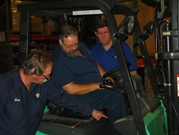
Online Training's Many Benefits
While the time savings vary greatly, a rough estimate is that safety managers spent 40 percent of their time delivering training in the pre-online era and now spend 10 percent of their time on it.
- By Jerry Laws
- Nov 01, 2010
David Cox, CSHM, Facilities Services safety manager at Grand Valley State University (www.gvsu.edu/facilitiesservices/) in Allendale, Mich., is a firm believer in online training because it benefits the university and its employees alike. About 150 people currently work in the FS department. "We always struggle with trying to fit it in with not only the workers, but the managers, so we have to try different modes to adapt to the situation," he explained.
He said a typical example is their hi/lo operator training. Done in a classroom, it may pull the workers away from their assignments at a busy time. "If they come and it's a bright, sunny, 75-degree day, they're just scrambling because they pick the best days to do grounds work, and they're preparing for a football game. So then it becomes difficult to plan a set time," Cox said. "With the grounds department, it's much easier to do training with them on a rainy day. That's kind of hard to predict three weeks out."
Delivered online, however, the hi/lo course is ready for the employees to take whenever they sit down at a computer during the next rainy day. They take the course, then go to a warehouse for a hands-on session operating the machine, Cox said.
This is one of more than 20 online courses the department uses to train the workforce on ladder safety, Hazard Communication, driver awareness, bloodborne pathogens, aerial safety, and more topics. Because the workers enjoy their time spent in training this way, the department may add more online courses, such as a first aid refresher, Cox said. Hands-on sessions demonstrate and practice the use of PPE and are included in safety meetings to reinforce the online training.
Time and Money Saved
About 40 students are enrolled in the university's Occupational Safety and Health Management degree program (www.gvsu.edu/osh/), where Cox is an adjunct faculty member. He is using online courses in a pilot program to deliver OSHA 30-hour construction training to these students.
 "Online itself doesn't get all the information across. You have to touch things," he said. "I'm of the belief that pure online training is not the best for teaching college students, if they never come into a classroom. I like to combine the two, where they do the online training at home -- it's no different than reading a textbook, and actually it's easier because it's interactive -- and then when they get to the class, we can talk a bit more, you can look up fatal facts on [OSHA.gov] and look at reports of fatal accidents in the topic we're looking at. They can feel and touch the things that they're doing, such as the harnesses."
"Online itself doesn't get all the information across. You have to touch things," he said. "I'm of the belief that pure online training is not the best for teaching college students, if they never come into a classroom. I like to combine the two, where they do the online training at home -- it's no different than reading a textbook, and actually it's easier because it's interactive -- and then when they get to the class, we can talk a bit more, you can look up fatal facts on [OSHA.gov] and look at reports of fatal accidents in the topic we're looking at. They can feel and touch the things that they're doing, such as the harnesses."
Cox graduated from the program in 1984, when all training took place in classrooms. Today, online training adapts to the needs of all concerned, ultimately saves the employer money because of the productivity benefits gained, and has slashed the amount of time safety managers spend training others, he said. While Cox said the time savings vary greatly, his rough estimate is that safety managers spent 40 percent of their time delivering training in the pre-online era and now spend 10 percent of their time on it. "It allows us as safety managers to work on other projects. It's the classic doing more with less," he said, "and it's a huge benefit to safety managers."
Administrators can download attendance on an Excel spreadsheet and send it to department heads.
Streaming video comes in handy for both college classes and employee meetings. Cox simply calls up a 10- to 20-minute safety presentation using his laptop and speakers. "They have a four-page list of streaming video, and that's beneficial because it's easy to pick the topic ahead of time and pull it off the web," he said. "The second thing that's easy is with multiple shifts and remote locations: I can show a third-shift supervisor how to pull it up. Say they want to do something on bloodborne pathogens at 11 o'clock at night or another city. Well, it doesn't require the safety manager to come in; all the safety manager has to do is show the supervisor how to log in. Then they can spend 20 or 30 minutes of their safety meeting going over that topic."
Online 10- and 30-Hour Use Soars
Demand at this time for online OSHA 10- and 30-hour courses "is huge," said Sara Wesche, marketing director for Summit Training Source, a provider of online training courses. "It's almost become the compliance training standard, in a way. We're seeing companies, even in the states where they don't mandate it in any way, shape, or form, using that as their baseline, like a new employee orientation. Or everybody on the job site, they want employees to have at least 10-hour and supervisors to have 30-hour. It's almost become the way video [training] sales were in the '80s and the '90s, before online training came along."
Several states, mostly in the northeastern United States, now require OSHA 10-hour training for anyone working on construction and public works projects. Nevada this year began requiring all workers at construction sites to complete the 10-hour construction course and all supervisors to complete the 30-hour course.
"I think the online offers some advantages and possibilities that classroom does not. Of course, I'm biased," Wesche said. "A couple of main advantages with the online: You have up to six months to complete the training, so instead of pulling your guys in off the line, off the shop floor for two days or three days of solid training, you can schedule it out to where they're doing an hour or two hours at a time, however the company wants to handle it. You can do it with multiple shifts. Online offers that flexibility.
"Also, the recordkeeping side of it. The training administrator can see where students stand, which courses they've completed, how well they have performed, how much of the training they have left to complete." And with the records in hand, they're ready if an OSHA or state inspector knocks on the door, Wesche added.
"We're seeing an increased use of blended solutions, increased use of multiple formats," she said. "People are using the online OSHA 10-hour and 30-hour, they'll have additional online courses, and then have the streaming video. They are using all the different media that are available, which I think is really cool. I'm sure other vendors in the training space that offer different formats are seeing the same thing."
Customers will use streaming video for safety meetings so they can focus on a problem or issue for that specific site, she said. For larger groups on a corporate level, they'll use online training courses instead.
Definitions in Nevada's Mandatory 10- and 30-Hour Regulation
"Construction worker" defined.
1. "Construction worker" means a person who actually performs physical work at a construction site:
(a) That results in the construction, alteration or destruction involved in the construction project, including, without limitation, painting and decorating; or
(b) Who supervises any person engaged in work described in paragraph (a).
2. The term does not include a person to the extent that the person performs or supervises another person who performs work which is conducted:
(a) For the upkeep of an existing property for which a certificate of occupancy has been issued by the appropriate building inspector or other authority; and
(b) To prevent the property from degrading, to maintain the property in its original condition or to maintain the operational soundness of the property, including, without limitation, by repairing components of the property or by replacing components of the property with the same or similar components.
"OSHA-10 course" defined.
"OSHA-10 course" means a 10-hour course in construction industry safety and health hazard recognition and prevention developed by the Occupational Safety and Health Administration of the United States Department of Labor.
"OSHA-30 course" defined.
"OSHA-30 course" means a 30-hour course in construction industry safety and health hazard recognition and prevention developed by the Occupational Safety and Health Administration of the United States Department of Labor.
"Supervisory employee" defined.
"Supervisory employee" means any person having authority in the interest of the employer to hire, transfer, suspend, lay off, recall, promote, discharge, assign, reward or discipline other employees or responsibility to direct them, to adjust their grievances or effectively to recommend such action, if in connection with the foregoing, the exercise of such authority is not of a merely routine or clerical nature but requires the use of independent judgment. The exercise of such authority shall not be deemed to place the employee in supervisory employee status unless the exercise of such authority occupies a significant portion of the employee's workday.
www.leg.state.nv.us/NRS/NRS-618.html#NRS618Sec950
This article originally appeared in the November 2010 issue of Occupational Health & Safety.